Steve Pace
Aviation History Writer
- Joined
- 6 January 2013
- Messages
- 2,266
- Reaction score
- 220
Does anyone have any high res images of these three experimental Mustang prototypes? -SP
The XP-51G was fitted with a Rolls-Royce manufactured Merlin RM.14.SM & one of the pair received a Rotol wooden 5-bladed prop "temporarily". NAA test pilot Bob Chilton said the prop caused directional instability (source: the Crowood tome). Given the 5-bladed props' fairly wide fitment to Spitfires, maybe the lightweight Mustangs needed a little more fin area? The G already had a small fin extension compared with the F model, so a case of more is more? Perhaps the H model's altogether taller fin?Interested in the propeller. Was it a completely new design, or derived from another, like those found on late Marks of the Spitfire?
The five bladed one.
In the Rolls Royce Heritage Trust book, Rolls Royce and the Mustang, it explains that when RR were modifying the Mustang Mk.I's to Merlin power and started testing it, they found that the Merlin caused more yaw problems than what the Allison did. Some wind tunnel testing revealed that the aircraft needed more fin area. RR solution was to add 3" to the leading edge of the fin, top to bottom and this resolved the problem. This extension was added to all five of the Mustang X's.Given the 5-bladed props' fairly wide fitment to Spitfires, maybe the lightweight Mustangs needed a little more fin area? The G already had a small fin extension compared with the F model, so a case of more is more? Perhaps the H model's altogether taller fin?
I have some WIPs and had planned to use F2H Banshee canopies. I’ll have to look at the FJ-1s.OM, yes, now looking at the photos up close with a magnifying glass, the serial number does look like FR409 --
I was puzzled for the longest time as to why NAA put such a huge canopy on them, but finally found evidence as to why. They had raised the whole cockpit up and these nice photos emphasize it very well. I've got a model build going where I'm making all these XP-51's and it took me a while to find a canopy for them, finally found what I need after I had got a couple of FJ-1 Furys and then found I could get aftermarket clear vac canopies.
Look in JAYS Models New Zealand websiteI have some WIPs and had planned to use F2H Banshee canopies. I’ll have to look at the FJ-1s.OM, yes, now looking at the photos up close with a magnifying glass, the serial number does look like FR409 --
I was puzzled for the longest time as to why NAA put such a huge canopy on them, but finally found evidence as to why. They had raised the whole cockpit up and these nice photos emphasize it very well. I've got a model build going where I'm making all these XP-51's and it took me a while to find a canopy for them, finally found what I need after I had got a couple of FJ-1 Furys and then found I could get aftermarket clear vac canopies.
OKJusto, the XP-51 with the 5-blade prop is the XP-51G
Hello Sir
Hello Sir
I was enormously pleased to find the three high resulution pictures of the 3rd P-51F here, they are part of AF technical report 5653 dated 4 december 1947 .
In that tech report a fourth picture (picture 158419) was also givven. the one i have attached .
Did you by chance find this three quarter rear view i the same high resolution also?
Eagerly awiting your answer
Sincerely
H Meijer
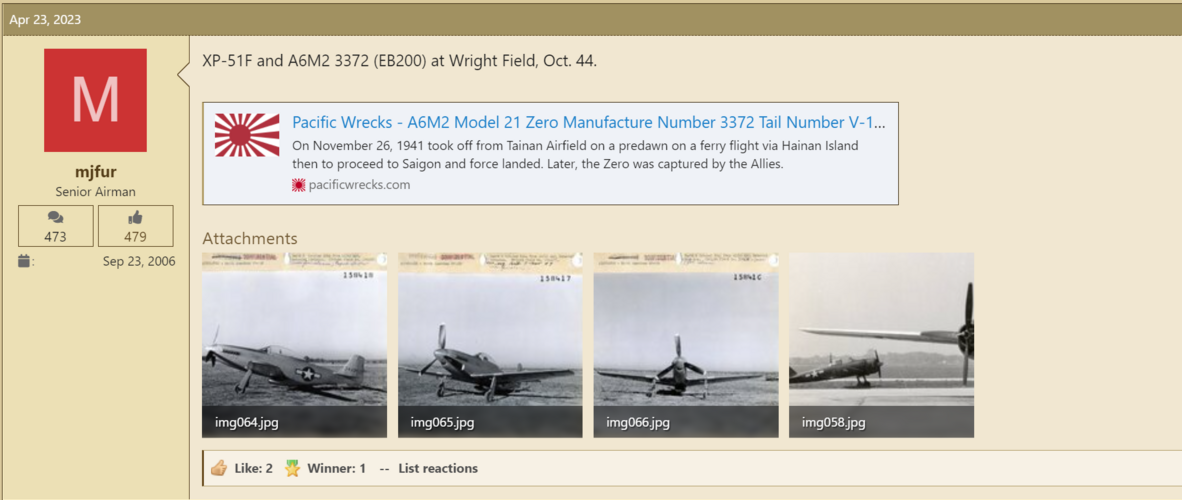

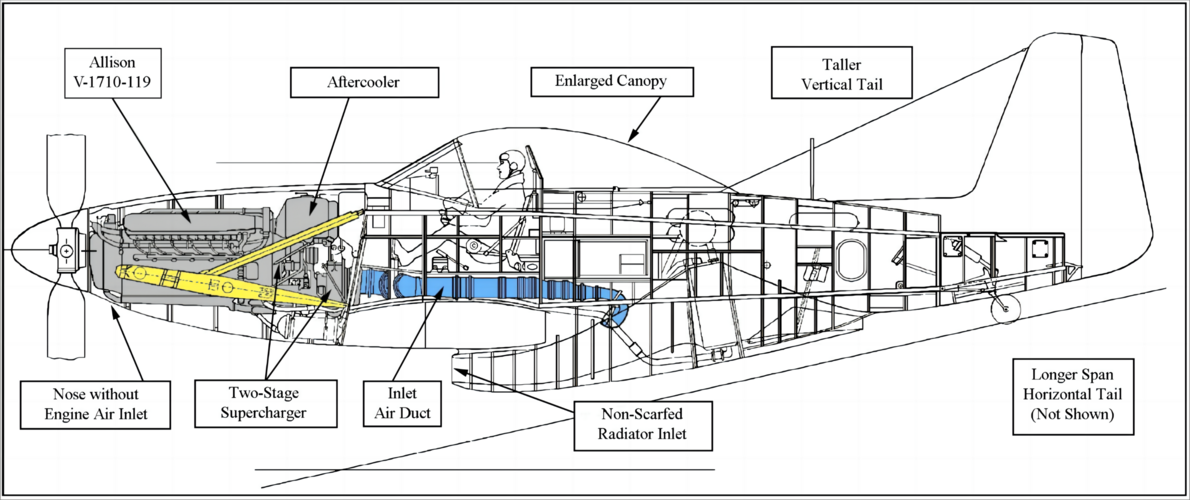


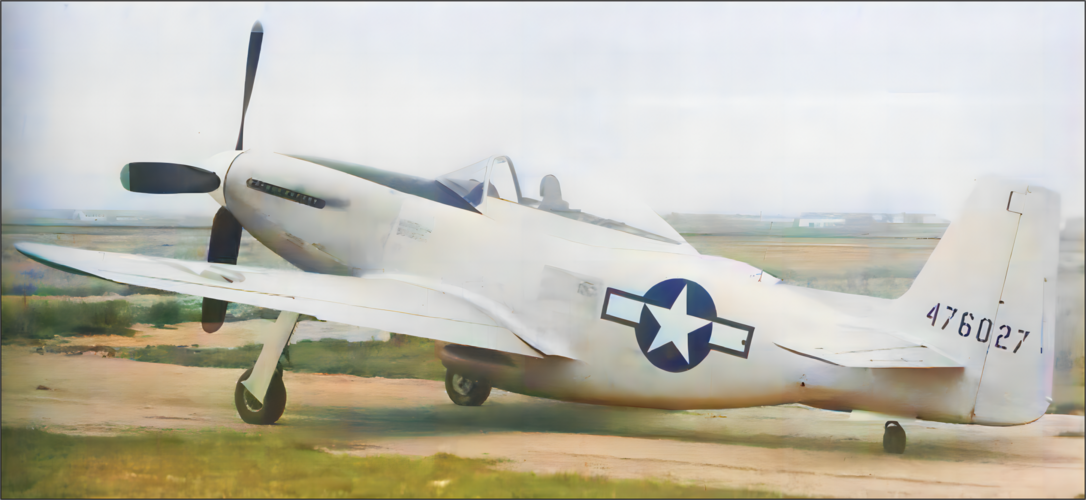
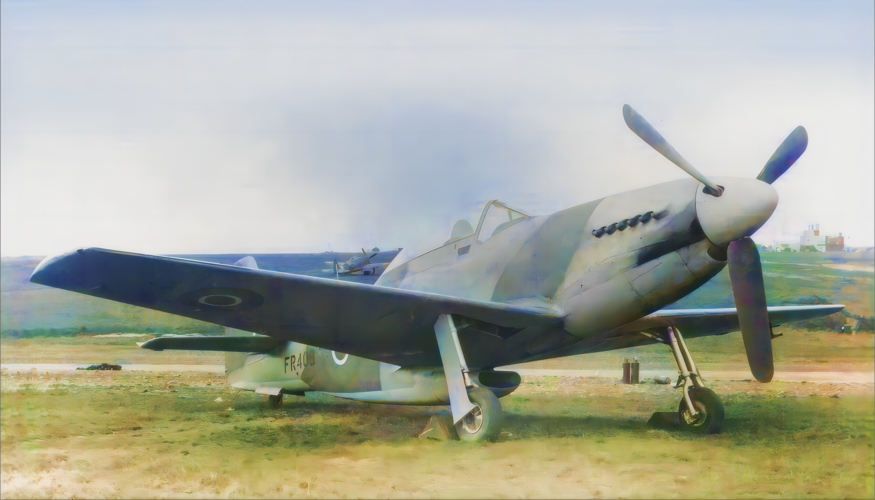



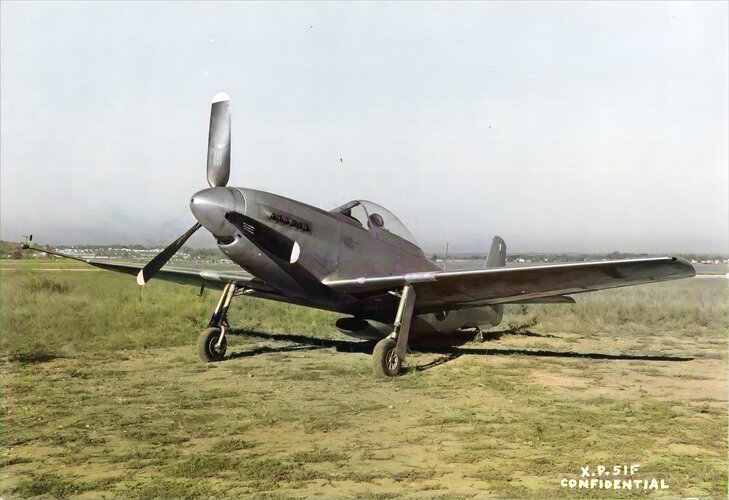

I would offer an addition to the comments. AL 963 had the fin chord extension as you mentioned, but it was preceded by the dorsal fin mod - while the DF mod was deemed slightly less effective, the chord mod was deemed to make the Mustang response to roll input less desirable.In the Rolls Royce Heritage Trust book, Rolls Royce and the Mustang, it explains that when RR were modifying the Mustang Mk.I's to Merlin power and started testing it, they found that the Merlin caused more yaw problems than what the Allison did. Some wind tunnel testing revealed that the aircraft needed more fin area. RR solution was to add 3" to the leading edge of the fin, top to bottom and this resolved the problem. This extension was added to all five of the Mustang X's.
They looked like this below, this is the last iteration of the Mk.X.
He was wrong. Although the D was heavier due to increased firepower (2x 50 cal plus 600 rnds of ammo) the fuselage/canopy design with better windshield and flow properties, combined with much better pylon reduced P-51 parasite/form drag co-efficients below the P-51B/C. It was clean enough to offset slight increase in Induced Drag due to 500+ pounds of additional GW,I wonder if the larger canopy had an aerodynamic element to it. I saw an interview with a Mustang pilot who stated that the earlier aircraft were faster due to better aerodynamics compared to the bubble type canopy.
Some good data, some a little off based on my sources. Wondering what yours are particularly with respect to GW, flight test comparisons,etc.North American P-51 Mustang evolution
In spring 1943 the Americans launched five programmes to improve the P-51 D performances.
For a weight saving, the airframe was extensively redesigned as XP-51F. To eliminate unnecessary structure, high-strength 75 ST aluminium and plastics were also employed. Principal changes included a much thinner cross-section wing, with straight leading edge, a lighter landing gear with small wheels and removal of the fuel tank behind the pilot.
To save drag, the radiator housing was redesigned with a smaller chin scoop.
The only added weight was due to the fitting of a longer bubble canopy that required one hydraulic device to move.
On February 1944 the XP-51F performing its first flight.
The prototype weighted 1,468 kg (3,229 lbs) less than the P-51 D-NA and was 47 kph (29 mph) faster powered by the same engine. To save weight the standard airscrew was replaced by one hollow-steel, three-bladed Aero Products propeller, the armament was reduced to four 0.50 cal machine guns with 250 rounds per gun and the oil cooler was replaced with a heat exchanger.
The XP-51 G was flown in 9 August 1944, powered by one 1,500 hp. Rolls-Royce Merlin 14 SM engine driving a five-bladed Rotol airscrew with 3.35 m (11 ft) of diameter. The British engine reaching 2,200 hp. emergency power burning 150 octane fuel, 130 per cent more power than the original engine.
The XP-51 G weighted 1,546 kg (3,401 lbs) less than the P-51 D-NA and was 57 kph (35.4 mph) faster.
Only two prototypes were built.
On 3 February, 1945 the P-51 H first flight tests were performed, powered by one Allison V-1650-9 engine, with 370 hp less than the V-1650-7 standard used by the P-51 D-NA. The P-51 H was 81 kph (50 mph) faster and weighted 370 kg (814 lbs) less, with the same armament.
Over 370 units were delivered to the USAAF prior the V-J Day, too late to see actual combat.
The fastest version of the line, named XP-51 J, was flown in 23 April, 1945 powered by one 1,500 hp. Allison V-1710-119 engine which offered over 1,720 hp. at 6,100 m (20,000 ft) altitude, with water injection and 150 octane fuel.
The prototype weighted 1,432 kg (3,150 lbs) less than the P-51 D-NA and was 87 kph (54 mph) faster.
To save drag the cooling systems were redesigned, with coolant and oil radiators in one ventral fairing. The carburettor intake was also moved to the ventral radiator scoop.
Only two prototypes were built.
On July 1944 the British launched a desperate attack against the new German cruise missiles V-1, to face the 'robot offensive' with their high performance interceptors Mustang Mk.III of RAF Squadrons 129, 306 (Polish) and 313 (Polish).
The aerodynamic drag of the V-1 airframe was higher than anticipated, due to low standards of manufacturing, decreasing from projected 900 km/h (559 mph) to the real 640 km/h (398 mph). Fortunately for the Allies this made the new missile susceptible to be intercepted by conventional fighters, but the game was dangerous.
They used to start the attack with a dive to gain speed, moving on to horizontal flight at 230 m behind the missile to be able to shoot it. The calculation of relative speeds was complicated, and some pilots died when firing from a too short distance.
It was necessary to modify the fighters to make them fast enough to intercept the V-1, the Mustang Mk.III changed their exhaust by those of the Spitfire engine that generated less drag, rear view mirrors and armour plates were also stripped. To reduce the drag on some airplanes, the camouflage paint was removed to gain some speed.
During the 'Operation Diver', between June 1944 and March 1945, sixteen squadrons of interceptors used the new aviation fuel ‘150 grade’ produced in the USA. Using trimethylpentane, that fuel had a higher octane-number, so allowed a higher compression and power output.
Thanks.He was wrong. Although the D was heavier due to increased firepower (2x 50 cal plus 600 rnds of ammo) the fuselage/canopy design with better windshield and flow properties, combined with much better pylon reduced P-51 parasite/form drag co-efficients below the P-51B/C. It was clean enough to offset slight increase in Induced Drag due to 500+ pounds of additional GW,
Long after war, David Lednicer confirmed NAA/NACA 1943-1944 wind tunnel tests with sophisticated CFD/Navier Stokes mesh models to compare the two.
I have both the drag reports as well as the CD build up for both (plus P-51H). The P-51H was the cleanest of all despite being a larger airframe/wing design over the B/D (and F/G/J)
The longer canopy profile as well as the longer aft radiator cooling exit cover were contributors to better aerodynamics to offset the increased profile drag of slightly 'taller' fuselage/canopy section.
Further, the NACA 66 series wing, while basically the same thickness/chord ratio as the NAA/NACA 45-100 wing was slightly less draggy in the low CL range of high speed/cruise
Chilton claimed 491 mph at 6230 GW but I have neither seen the test, nor fullyunderstand how the F without say, 75" boost and minumum fuel - could get there
